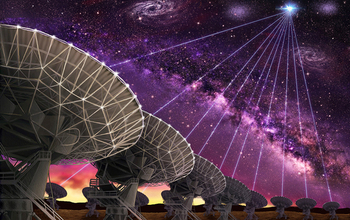Multimedia Gallery
VLA pinpoints location of radio burst in dwarf galaxy for first time
The Very Large Array pinpointed for the first time the location of a fast radio burst in a dwarf galaxy about 3 billion light-years from Earth.
More about this image
Astronomers have linked rare and brief bursts of cosmic radio waves that have puzzled astronomers since they were first detected nearly 10 years ago to a source: an older dwarf galaxy more than 3 billion light-years from Earth.
Initially, these fast radio bursts, which flash for just a few milliseconds, were thought to be coming from outside our galaxy, meaning they would have to be very powerful to be seen from Earth, because none of those first observed were ever seen again.
Then in 2012, a repeating burst was discovered, giving researchers an opportunity to repeatedly monitor its area of the sky with the Karl Jansky Very Large Array (VLA) in New Mexico and the Arecibo radio dish in Puerto Rico.
High-speed data recording and real-time data analysis software developed by an astronomer at the University of California, Berkeley, enabled the VLA to detect a total of nine bursts over a period of a month in 2016, sufficient to locate it within a tenth of an arcsecond. Subsequently, larger European and American radio interferometer arrays pinpointed it to within one-hundredth of an arcsecond, within a region about 100 light-years in diameter.
Deep imaging of that region by the Gemini North Telescope in Hawaii turned up an optically faint dwarf galaxy that the VLA subsequently discovered also continuously emits low-level radio waves, typical of a galaxy with an active nucleus perhaps indicative of a central supermassive black hole. The galaxy has a low abundance of elements other than hydrogen and helium, suggestive of a galaxy that formed during the universe’s middle age.
To learn more about this research, which was supported in part by the National Science Foundation, see the UC-Berkeley news story Fast radio burst tied to distant dwarf galaxy and, perhaps, magnetar. (Date image taken: 2016; date originally posted to NSF Multimedia Gallery: June 7, 2017)
Credit: Art by Danielle Futselaar (www.artsource.nl)
Images and other media in the National Science Foundation Multimedia Gallery are available for use in print and electronic material by NSF employees, members of the media, university staff, teachers and the general public. All media in the gallery are intended for personal, educational and nonprofit/non-commercial use only.
Images credited to the National Science Foundation, a federal agency, are in the public domain. The images were created by employees of the United States Government as part of their official duties or prepared by contractors as "works for hire" for NSF. You may freely use NSF-credited images and, at your discretion, credit NSF with a "Courtesy: National Science Foundation" notation.
Additional information about general usage can be found in Conditions.
Also Available:
Download the high-resolution JPG version of the image. (545.3 KB)
Use your mouse to right-click (Mac users may need to Ctrl-click) the link above and choose the option that will save the file or target to your computer.



